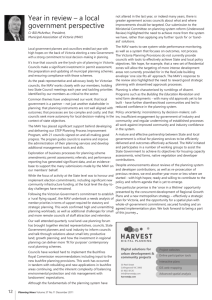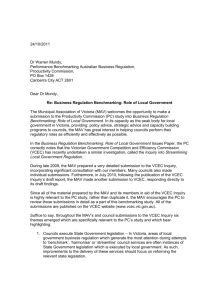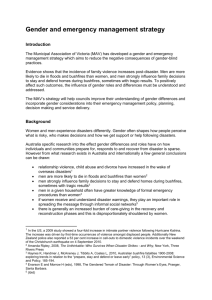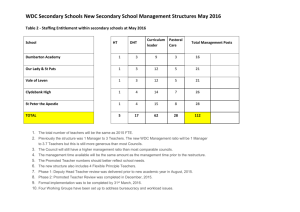Improving Emergency Management in Local Government (IEMLG
advertisement
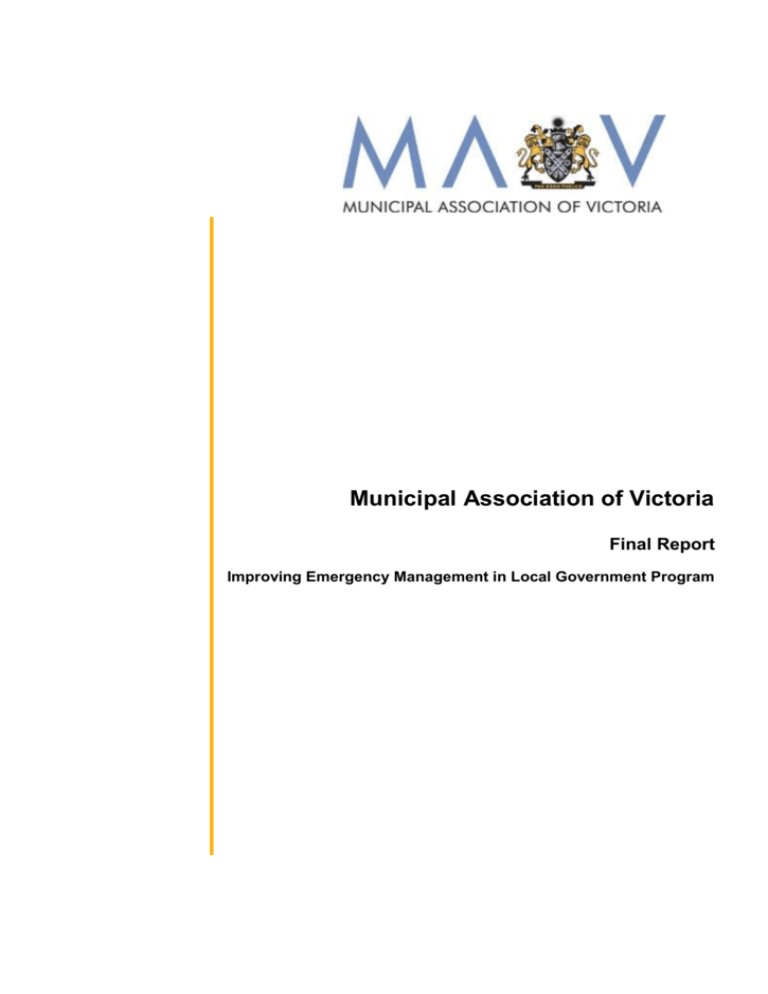
Municipal Association of Victoria Final Report Improving Emergency Management in Local Government Program 6 © Copyright Municipal Association of Victoria, 2014. The Municipal Association of Victoria is the owner of the copyright in the publication Improving Emergency Management in Local Government Final Report. No part of this publication may be reproduced, stored or transmitted in any form or by any means without the prior permission in writing from the Municipal Association of Victoria. All requests to reproduce, store or transmit material contained in the publication should be addressed to Emma Lake on elake@mav.asn.au. The MAV can provide this publication in an alternative format upon request, including large print, Braille and audio. The Improving Emergency Management in Local Government Final Report has been prepared by the Municipal Association of Victoria (MAV) for distribution to member councils and the State Government. The MAV would like to acknowledge the contribution of those who provided their comments and advice during this project, in particular the members of the IEMLG steering committee, councillor reference group and six project teams. Table of Contents Executive Summary ........................................................................................................ 3 1. Introduction ............................................................................................................... 4 1.1 Improving Emergency Management in Local Government program ....................... 4 2. Program Governance................................................................................................ 5 3. Program achievements ............................................................................................. 5 3.1 Policy and Role project .......................................................................................... 5 3.2 Legislative Change Project .................................................................................... 6 3.3 Financial sustainability project ............................................................................... 7 3.4 Capability building and shared services projects.................................................... 7 3.5 Performance measurement project ........................................................................ 8 4. Conclusion ................................................................................................................ 8 5. Attachments .............................................................................................................. 9 2 Improving Emergency Management in Local Government Final Report Executive Summary To support councils with the implementation of the Victorian Bushfires Royal Commission recommendations, the State Government provided the MAV with $2 million over four years to employ additional staff. The MAV used the staff to run the multi-project Improving Emergency Management in Local Government (IEMLG) program. The IEMLG program was developed in consultation with councils and State Government departments and agencies. Councils and the MAV recognised a need to better define the role of councils in emergency management, so that it better aligns with the skills, expertise and resources of local government. There was also a need for more consistency in professional development and the need for best practice arrangements to be developed and applied across the sector. The six projects that comprised the IEMLG program were: Policy and Role, Legislative Change, Financial Sustainability, Capability Building, Shared Services and Performance Measurement. Program outputs included: The future role of councils in emergency management position paper Survey and report on council expenditure on emergency management The MAV emergency management e-library Local Government Emergency Management Handbook Role of Mayors and Councillors in Emergency Management guideline Role of Council CEOs in emergency management guideline Professional development day for recovery managers Forum and guide on financial management of emergencies Baseline survey on council emergency management capabilities Development of a local government surge team concept for consideration by councils The underlying success of the program was the collaborative approach taken by both councils and the State. The collective efforts of program participants has lifted the profile of emergency management across the sector and resulted in a number of commitments from the State Government though the White Paper process. The feedback received from councils, State Government partners and other stakeholders has been extremely positive and the MAV is confident that the various IEMLG initiatives have improved councils’ understanding of their emergency management role and resulted in increased capability. 3 Improving Emergency Management in Local Government Final Report 1. Introduction To support councils with the implementation of the Victorian Bushfires Royal Commission recommendations, the State Government provided the MAV with $2 million over four years to employ additional staff. The grant was administered through Local Government Victoria. The MAV used the additional staff to run the multi-project Improving Emergency Management in Local Government (IEMLG) program which, in addition to being a performance improvement program, provided a means for establishing councilendorsed policy positions that the MAV used in its work with the State Government on the current reform agenda. 1.1 Improving Emergency Management in Local Government program The IEMLG program was developed in consultation with councils and State Government departments and agencies. Through the consultation phase, the MAV identified that the expectations and obligations placed upon councils were significantly increasing in emergency management planning, community education and consultation, mitigation activities, as well as more traditional response, relief and recovery activity. Given the previously ad hoc nature of emergency management funding, and the varied risk profiles and capacity of Victorian councils, there was a lack of consistency in councils’ approach to emergency management. Councils and the MAV recognised a need to better define the role of councils in emergency management, so that it appropriately matched the skills, expertise and resources of local government. There was also a need for more consistency in professional development and the need for best practice arrangements to be developed and applied across the sector. The six projects that comprised the IEMLG program were: Policy and Role Legislative Change Financial Sustainability Capability Building Shared Services, and Performance Measurement. 4 Improving Emergency Management in Local Government Final Report 2. Program Governance Each of the projects was overseen by a project team comprising council officers and State agency representatives. A steering committee made up of seven council CEOs and representatives from lead state agencies, and a councillor reference group were also established. The steering committee was jointly chaired by the MAV CEO and a representative from the Office of the Emergency Services Commissioner. More than 40 councils were represented on the program committees. MAV Board Program Sponsor IEMLG Program Steering Committee Councillor Reference Group Co-chairs: MAV CEO and Office of the Emergency Services Commissioner IEMLG Program Manager Seven council CEOs Victoria Police Department of Human Services Victoria State Emergency Service Improving what we do Defining what we do Policy and Role Project Legislative Change Project Sustainable Funding Project Capability Building Project Shared Services Project Performance Measurement Project Project Manager Project Manager Project Manager Project Manager Project Manager Project Manager Project team Project team Project team Project team Project team Project team Timeframe: 2011 Timeframe: 2011 – 2014 Timeframe: 2011 – 2012 Timeframe: 2011 - 2013 Timeframe 2011 – 2012 Timeframe 2011 – 2014 5 Improving Emergency Management in Local Government Final Report 3. Program achievements 3.1 Policy and Role project A policy position paper was developed with Victorian councils to provide a consolidated view on the future role for local government in emergency management. The consultation process was exhaustive. It included six regional workshops for councillors and council officers, a stakeholder workshop with representatives from 20 agencies and an opportunity for councils to provide written feedback on the draft position paper prior to MAV Board endorsement. The paper takes into account the sector’s capabilities, strengths and limitations. It provides a description of the key responsibilities councils should hold in an integrated emergency management framework and a rationale for each of the statements. The policy position was the foundation of the MAV’s submission to the Emergency Management Green Paper, Towards a More Resilient and Safer Victoria (2011), and advocacy relating to legislative change and sustainable funding throughout the White Paper reform period (December 2012 onwards). The position paper was recognised in the State’s Victorian Emergency Management Reform White Paper: ‘There is an urgent need to clearly enunciate the roles of local government in emergency management. These roles must be in line with the strengths, capabilities and unique positioning of councils.’ (page 15) Action 9: Review all legislation that allocates emergency management responsibilities to local governments (including the Local Government Act 1989) to clarify local government’s roles in emergency management, taking into account work already undertaken by the Municipal Association of Victoria on the future role of local government in emergency management and its analysis of relevant legislation. Project achievement: The future role of councils in emergency management position paper. 3.2 Legislative Change Project The project team undertook an analysis of international and Australian legislation to provide a point of comparison for Victorian legislative obligations and use of legislative instruments. A table of councils’ emergency management obligations across the planning, prevention, response and recovery spectrum was developed and later used in the Local Government Emergency Management Handbook (mentioned below). The Legislative Change project was put on hold while the State Government finalised the Emergency Management Reform White Paper but was reconvened in September 2013 to consider the Department of Justice’s proposed reform of emergency management legislation. It is intended that the legislative change group will have an ongoing role as a reference group throughout the 2013-2016 reform period. 6 Improving Emergency Management in Local Government Final Report Project achievements: Report providing feedback to the Department of Justice on the 2013/14 legislative reform proposals Table of local government emergency management obligations in Victorian legislation Report on Australian and international emergency management legislation 3.3 Financial Sustainability project The project team designed a significant survey of councils’ emergency management expenditure. The objective of the survey was to capture recurrent costs, including the costs of routine mitigation activities. Data was collected and collated in the first half of 2012. Approximately 60 per cent of councils responded. Many councils found it difficult to extract emergency management expenditure from their current financial systems. For many councils the process itself was enlightening, as it was the first time any whole of organisation assessment of expenditure in this area had been attempted. Project achievements: Survey and report on council expenditure on emergency management. 3.4 Capability Building and Shared Services projects These projects were consolidated after the first year. Their purpose was to develop tools and resources, programs and activities that improve council performance in emergency management. The projects also aimed to promote better arrangements for sharing and managing emergency activity across the local government sector. Achievements included the development of the MAV emergency management elibrary which is a depository of council and MAV-developed resources including research, guidance and protocol documents. The capability building project team also provided input into the development of the Local Government Emergency Management Handbook which outlines legislation and policy relating to councils’ role in emergency management. The handbook serves as an induction manual and can assist with recruiting staff. Guidance material was developed for councillors and council CEOs which provides advice on their roles before, during and after an emergency. Based on some of the needs identified through discussions with councils, a guidance document on the financial management of emergencies was developed in consultation with the Department of Treasury and Finance (DTF). It was launched at a forum that included speakers from DTF, VicRoads, the MAV’s insurance counsel and two councils with recent experience of emergencies. While not a direct output of the project teams, the teams provided valuable insight into the resource constraints of rural councils. This insight informed the MAV’s 7 Improving Emergency Management in Local Government Final Report application for grant funding to run a ‘Cluster Pilot Project’, which involves four councils in and around Bendigo. The pilot was cited in the White Paper as a means of investigating opportunities for municipalities to come together to form ‘clusters’ for emergency management purposes (pg 30). Clustering provides benefit to councils by pooling resources and expertise, it also allows for integrated planning for risk footprints that extend beyond the boundaries of a single municipality. The four partner councils have recently agreed on the level of collaboration and have signed a Memorandum of Understanding. Further work is required to understand the risks and benefits of this model. Project achievements: The MAV emergency management e-library Local Government Emergency Management Handbook Role of Mayors and Councillors in Emergency Management guideline Role of Council CEOs in emergency management guideline Forum and guide on financial management of emergencies Input into the development of the local government surge team concept Input into the cluster pilot project 3.5 Performance measurement project In August 2012 the MAV conducted a survey to collect baseline data on a range of indicators of capability. To the best of our knowledge this is the first survey undertaken of councils’ emergency management capability in Victoria. The results provide a valuable overview of the current emergency management capability levels of councils and identify a selection of performance indicators for future surveys. The project team is continuing to work with the Office of the Emergency Services Commissioner (OESC) to support the development of the Inspector-General Emergency Management (IGEM) performance measurement and improvement regime. Project achievements: Baseline survey on council emergency management capabilities Feedback to OESC/ IGEM monitoring and assurance framework 4. Conclusion The substantial grant funding received in 2011 provided an opportunity for the MAV to make a significant improvement to the performance of councils in emergency management. The underlying success of the program was the collaborative approach taken by councils and the State Government. The collective efforts of program participants has lifted the profile of emergency management across the sector and resulted in a number of commitments from the State Government in the White Paper. The feedback received from councils, State Government partners and other stakeholders has been extremely positive and the MAV is confident that the various 8 Improving Emergency Management in Local Government Final Report IEMLG initiatives have improved councils’ understanding of their emergency management role and resulted in increased capability. The research undertaken is a valuable resource for the MAV and State Government, and with some further work could go a long way to providing a comprehensive picture of the local government contribution to emergency management. There is a risk that the momentum built through the program will stall without continued funding and the subsequent reduction in MAV emergency management capacity; however, many of the program initiatives were designed to have a life well beyond the program. The products developed and the networks established provide a platform for future improvements in council capability and capacity in emergency management. 9 Improving Emergency Management in Local Government Final Report
